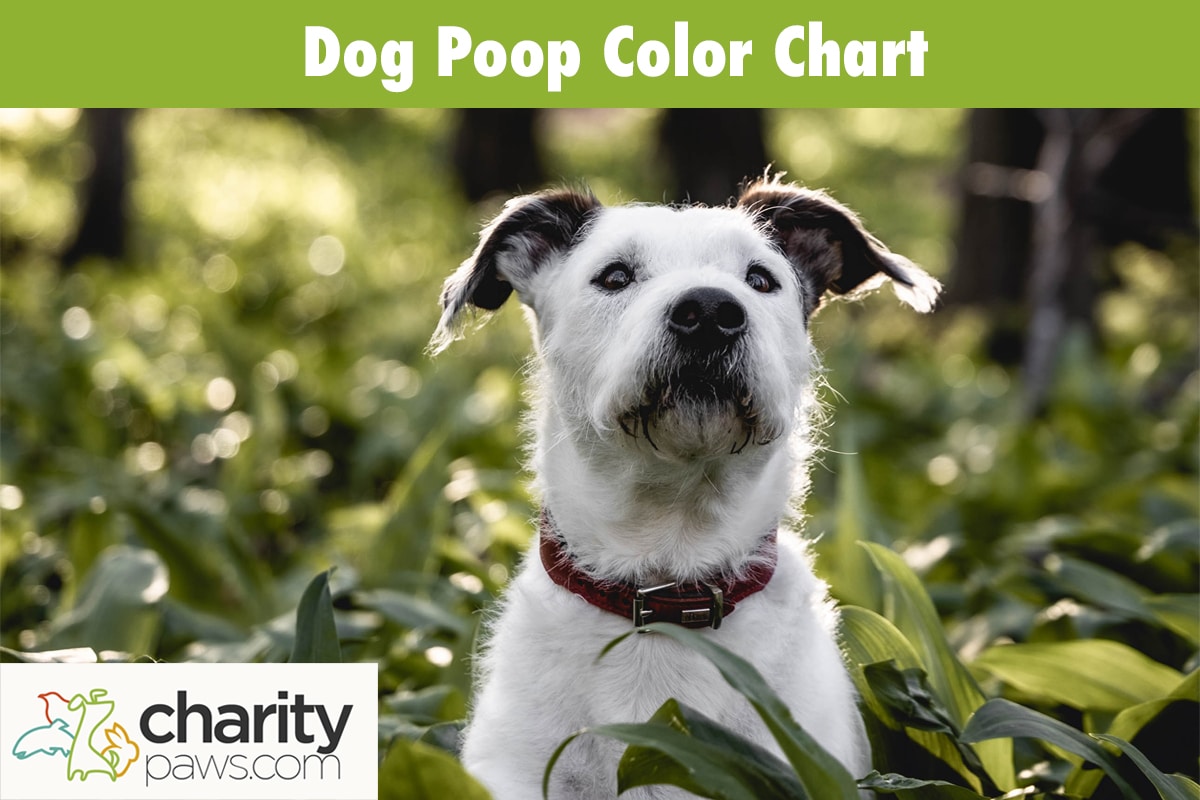Did you know that the color of your dog’s poop can offer you a wonderful peek into their current state of health?
The color of your dog’s poop may seem insignificant to some, but it can actually tip you off to an array of underlying complications.
Just like your dog’s vomit color can indicate health problems, we look at your dog’s poop color to get an inside look at what may be going on inside of your dog’s intestines.
While it may seem strange to observe your dog’s poop color each time they pass stool, it is a wonderful way to be proactive about their digestive health.
So what does the color of your dog’s poop mean?

Should I Pay Attention To The Color Of My Dog’s Poop?
Yes, you should always pay close to attention to the color of your dog’s poop.
Not only can certain colors of dog poop point to different underlying complications, but a sudden change in poop color can point to illness as well.
Many health threats are missed when the appearance of a dog’s poop is ignored, so this is an easy way to stay on top of your dog’s digestive health.
Below we will break down the different colors and what they could mean.
What Does Healthy Dog Poop Look Like?
Before we discuss the different poop colors you may see in your dog, you should first be aware of what healthy dog poop looks like.
This can not only help you stay on top of your dog’s gut health, but it can help you spot when something is abnormal.
In a healthy adult dog, their poop should be firm enough to pick up easily, and it should be a shade of chocolate brown.
Puppies should have a similar poop appearance, but their poop can be a bit softer at times, and it may be a lighter shade of brown.
Dog Poop Color Guide
To help you better understand what each color of dog poop means, let’s get into our dog poop color guide below.
Brown Poop Color
Brown poop in dogs is the standard color that you should expect to see.
Most dog poop will be a shade of chocolate brown, but this can vary slightly based on the type of food they consume.
As long as their poop is a shade of brown and it is firm enough to pick up easily, your pup’s digestive health is typically right on track.
A dog with diarrhea may be brown poop, but it is not firm enough to pick up easily so any kind of diarrhea should warrant a trip to your vet or at minimum a phone call.
Brown diarrhea needs to be watch, as something is upsetting your dog’s stomach.
Brown Poop With White Specks
While brown poop in dogs is typically ideal, you should not find any white specks in their poop.
There is a small chance that tiny white specks in their poop could be remnants of bone from their food, but it is more likely that these flecks are tiny intestinal parasites.
Tapeworms are the most common factor behind white specks in dog poop, as these worms look like small grains of rice.
Next time you see any white flecks in your dog’s poop, be sure to lean in and get a closer look.
If these tiny white specks are moving, it is safe to say that your pup has a case of intestinal parasites.
If this is the case, we suggest bringing a fresh stool sample to your vet.
Your vet can examine their stool under a microscope and prescribe the proper deworming agent your dog needs.
Green Poop Color
If you ever notice green poop in your pup, there are a couple possibilities that you should consider.
First, if it looks like there are green chunks of plant material mixed in with their brown poop, this could simply mean your dog has been eating grass.
This is usually nothing to be concerned with as long as the dog is not having diarrhea.
If your dog’s poop is actually green and there is no plant material present, this could point to a potential infection for GI upset and inflammation.
This could be a result of bacteria, intestinal parasites, and even dietary indiscretion.
If you ever notice green poop in your pup, we always suggest reaching out to your vet.
This is especially true if they are experiencing diarrhea or other GI symptoms.
Red Poop Color
If you ever see red streaks or a red color to your dog’s poop, this can point to the potential of bleeding in their lower digestive tract.
This can range from minor streaks of blood to jam-like diarrhea in dogs, both of which should warrant a call to your veterinarian.
Bloody stool can point to serious gastrointestinal upset in dogs, so it’s always best to reach out to your vet for guidance in these situations.
This is especially true if your dog is having bloody diarrhea, as this is considered a major medical emergency.
There is a possibility that red kibble can cause a red tinge to a dog’s stool, so if your dog is consuming red kibble, be sure to mention this to your vet when you give them a call.
Black Poop Color
Similar to red poop in dogs, black is another poop color that should always be taken seriously.
Black stool can point to the evidence of digested blood in the stool, often pointing to bleeding in the upper GI tract.
This could be a result of everything from stomach ulcers to intestinal parasites, all of which are considered a serious health threat.
No matter the consistency of your dog’s poop, you should always have them seen by a vet if their poop is black in color.
Purple Poop Color
If you ever notice purple poop in your dog, this is often just blood in the stool with a darker pigment.
Many owners have called their vets due to their dogs having sudden jam-like diarrhea, which is typically described as having a purple tinge.
Purple poop should be taken just as seriously as red poop, as this is likely still a sign of bleeding in their lower GI tract.
If your dog is passing purple poop or diarrhea, we suggest having them seen by a vet.
Gray Or White Poop Colors
If you suddenly stumble upon gray or white poop in your yard, there are a couple options to consider.
First, you should ask yourself how fresh this poop is.
If the poop has been sitting in the yard for an extended period of time, it is very possible that the stool is just dehydrated from the elements.
Poop can often appear white or gray the longer it sits outside, and does not indicate any type of underlying issue.
However, if your dog is passing stool that is gray or white, this could point to a digestive complication.
Improper function of the canine pancreas has been known to cause gray stool, so you will want to have your pup seem to rule out any underlying illnesses.
Concerning Dog Poop Colors To Watch Out For
As we mentioned above, a healthy dog with a balanced digestive tract should produce chocolate brown stool that is easy to pick up.
Any strange poop color should warrant a phone call to your vet, especially if the color of your dog’s poop changes abruptly.
Not only should a sudden change in your dog’s poop color warrant immediate concern, but so should the presence of other GI symptoms.
Other symptoms to be on the lookout for include:
- Soft stool
- Diarrhea
- Vomiting
- Drooling
- Anorexia
- Lethargy
- Abdominal pain
When To See A Vet Immediately
If your dog is having red, purple, or black stool, we suggest having your dog seen immediately.
This can point to the presence of blood in their stool, which can indicate a serious underlying complication.
Bloody stool can dehydrate a dog at a rapid rate, causing them to go into shock if the issue is left untreated.
Because of this, we always suggest having your pup seen for bloody poop.
Are There Differences Between Puppy Poop And Adult Dog Poop?
Though it’s not true of all puppies, there can be subtle differences in the appearance of puppy poop versus adult poop.
Most of these differences will hardly be noticeable due to how minor they are, but they are characteristics to be aware of if you have a puppy in your home.
First, it is not always abnormal for a puppy’s stool to be a bit softer than their adult dog friends.
Puppies typically eat more meals throughout the day, which means their poop moves through their digestive tract at a faster rate.
Because of this, their poop may be a bit softer.
Not only can their poop be a bit softer than adult dogs (though you should still be able to pick it up easily), it can also be a bit lighter in color.
Their poop should still be a shade of brown, but it may be lighter than the standard chocolate brown.

Final Thoughts On Dog Poop Colors
As you can see, poop color is a wonderful indicator of a dog’s current digestive health.
One thing to watch out for with your dog’s poop is the sudden change in colors.
Normally your dog’s poop color will be brown, but if you see yellow poop it could be a sign of parvo or other illness.
If your dog’s poop color changes from brown to another color and then back to brown, make note of that change and how long it took.
Keep watch over them to make sure they are not having any other health issues.
Sometimes our dogs eat something they should not and will experience a minor GI upset that usually resolves within 24 hours.
As mentioned above, if you see red, purple or black colors you should call your veterinarian immediately.
Be sure to keep an eye on your dog’s poop appearance going forward so you can spot any sudden changes in the future.

